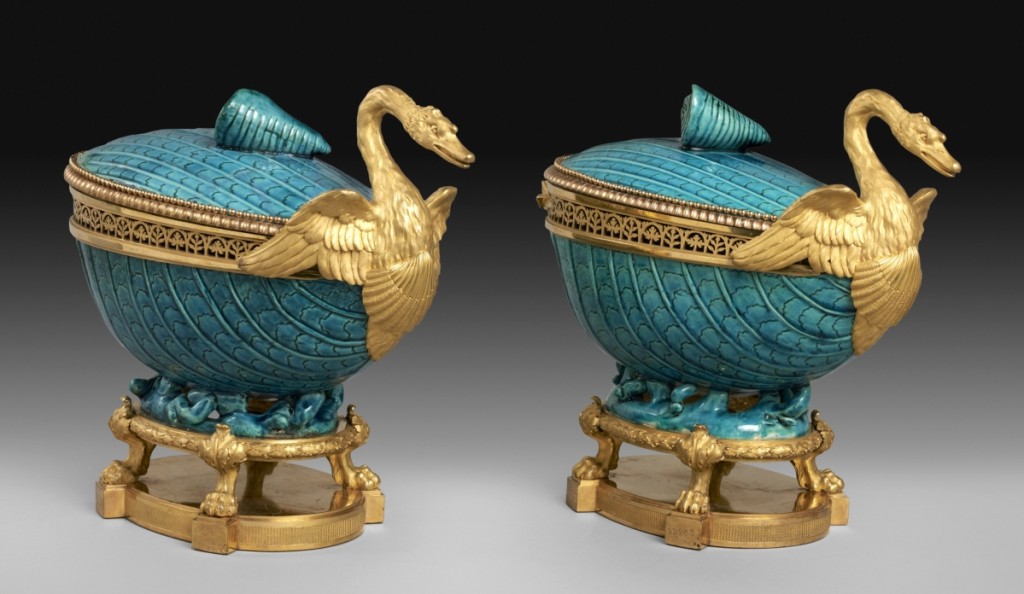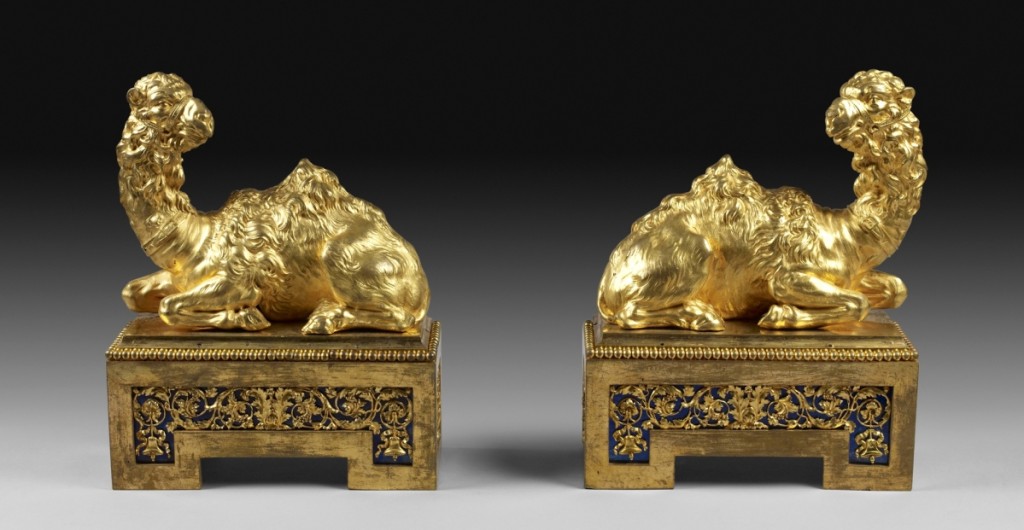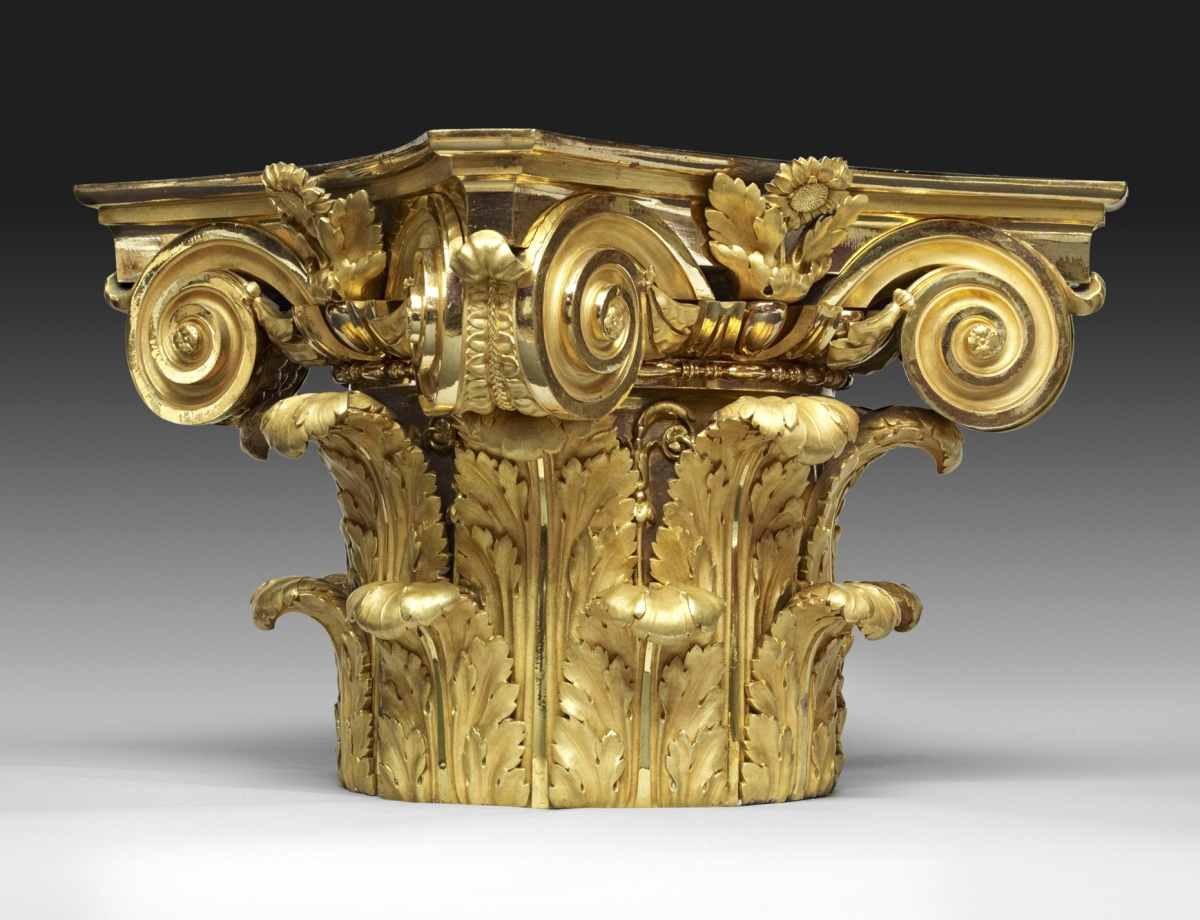
Two Eighteenth Century Chinese shell-form bowls became swan-prowed potpourri vases in the workshop of Gouthière. Possibly made for the Marquis of Clermont D’Amboise, they entered the Louvre collections in 1794, only two decades after their creation. Porcelain with gilt bronze by Pierre Gouthière, circa 1770−75. Each 11 by 12 by 7½ inches. Musée du Louvre.
By Karla Klein Albertson
NEW YORK CITY – Although studies on the careers of fine artists are common, rarely has the life and work of a brilliant craftsman received the comprehensive treatment presented by the exhibition and accompanying catalog for “Pierre Gouthière: Virtuoso Gilder at the French Court.” The project represents a meeting of minds between Charlotte Vignon, the Frick Collection’s curator of decorative arts; Joseph Godla, the chief conservator there; and art historian Christian Baulez, former chief curator at the Musée de Versailles.
After its run at the Frick ends on February 19, a version of the exhibition will be at the Musée des Arts Decoratifs in Paris from March 15 to June 25. Most important, the massive catalog with its collection of essays and detailed images will remain as a permanent record of the team’s research and conclusions. Published in both French and English editions, this definitive study of Gouthière’s oeuvre will be the standard reference for collectors and scholars seeking to understand his work.

In the hands of Pierre Gouthière, a skilled craft – the ability to create elaborate gilt-bronze ornaments – became artistry. The project to document his accomplishment sprang from the mind of Vignon, who had long been fascinated by a side table at the museum that was purchased by Henry Clay Frick in 1915. The curator explains, “At the Frick, we usually do exhibitions that are related to an artist or group of objects that is well known at the Frick. We take inspiration from the permanent collection. One of the key decorative arts objects at the Frick is that table in blue turquin marble that Gouthière made for the Duchess of Mazarin. I wanted to know more about this man.
“I love the idea of monographic exhibitions in the field of the decorative arts because I don’t think there are enough,” Vignon continued. “Gouthière is a typical case in one way because he is a very, very famous maker in the field of Eighteenth Century decorative arts, but he’s not that well known to the larger public. Also, he is not someone who has been studied recently. He had a monograph in the early Twentieth Century, but there was much more research to be done. I thought it was a great possibility for studying in depth one object in our collection and at the same time doing an academic and well-researched work that could be important in the field of Eighteenth Century studies and decorative arts studies.”
Little is known about the early life of Pierre Gouthière before he came to Paris. He was baptized in 1732 in the Champagne region where his father was a saddler, but we do not know why he chose to enter the Parisian workshop of chaser-gilder Francois Ceriset. The master’s training seems to have awakened a natural talent in his student. When Ceriset died in 1756, Gouthière took over the workshop and arranged to marry his master’s widow. For 30 years, he successfully worked from the patterns of gifted architects and designers, translating their flat classical drawings into three-dimensional gilt-bronze objects. His commissions came from the luminaries of the day ‑- members of the royal courts of Louis XV and Louis XVI; Queen Marie-Antoinette; the Duke of Aumont and his daughter-in-law, the Duchess of Mazarin; and Louis XV’s famous mistress, the Countess du Barry.

Commissioned for Marie Antoinette, these exotic dromedary fire dogs would have been the finishing touch for a chimneypiece in her Cabinet Turc at Fontainebleau. Later, they graced the library of Empress Josephine. Pair of fire dogs by Pierre Gouthière, 1777. Gilt bronze and blued steel, 12¾ by 8 by 4 inches. Musée du Louvre
Unfortunately, Gouthière got stiffed, in modern parlance, by the rich and famous who never paid the man the hard cash they owed for the work. He declared bankruptcy in 1787 and worked little during the turbulent period of the Revolution, when all that glitters went out of style. He died a poor man.
As France moved into a new age, interest in his surviving work rebounded. Vignon says, “Very, very early in the Nineteenth Century, people were already looking for Gouthière pieces, but at the same time also confusing what he was doing. So the myth around Gouthière – what he produced and who he was – started very early on, almost immediately after he died in 1813.” Helen Jacobsen, chief curator at the Wallace Collection in London, explores some of this early enthusiasm for his work in her catalog essay exploring Nineteenth Century British collectors of the material.
Over time, more examples of gilt bronze of the period came to be attributed to Gouthière’s workshop. In a major contribution, Godla, in his essay “‘Twenty Fingers on Each Hand’: Pierre Gouthière’s Chasing and Gilding Techniques,” was able to establish definitive physical criteria for which pieces can or cannot be attributed to the master craftsman. In conclusion, Godla writes, “Despite the absence of signature, it is now possible to differentiate his work from that of other talented, contemporary bronze-makers like Francois Remond and Etienne Martincourt. A great modeler, an exceptional chaser and an excellent and innovative gilder, Gouthière created pieces that, at their best, are beautifully sculpted, full of life and expression and richly textured and gilded.”
Vignon agrees that studying the technical points of his work was an important aspect of the project. She says, “Because Gouthière is loved, known, collected forever, everything is attributed to him. We really don’t know what he did and, at one point, we start losing the corpus, and we start not understanding who he was and his production. So it was an opportunity to reevaluate all of that, to put on display a group of objects that are definitely by him. It allowed us to study him, his production, his technique and his style. Ultimately, each great maker and artisan deserves an exhibition like that. They are done for painters and sculptors. We should do the same thing in the field of decorative arts.”

The Duke of Aumont had a collection of antique columns, 11 of which were ornamented with gilt-bronze additions by Gouthière. Purchased for Louis XVI in a sale after Aumont’s death, the vibrant Corinthian capital and associated base were part of the founding collection of the Louvre. Column capital by Pierre Gouthière, probably after a design by François-Joseph Bélanger, circa 1775−80. Gilt bronze, column dimensions 97 by 14 by 8 inches. Musée du Louvre. —Thierry Ollivier photo
Godla’s chapter on Gouthière’s techniques goes into well-illustrated detail. For the exhibition, the museum created a special film to accompany the written description. Available to everyone visiting the exhibition or online at the Frick website or YouTube, a video re-creation of the mind-boggling process of creating even a small knob for a French window immediately enhances the appreciation of Gouthière’s genius. The craftsman was not just a mold maker or a gilder. He spent hours using his talent as a sculptor to chase and finish each surface of the creation. The film features living artists who still perform these skills. In one scene, the viewer can glimpse the hundreds of chasing tools used to create the subtle variations in surface texture.
The exhibition displays 21 masterworks by Gouthière, grouped by the patron who commissioned them. It is worth noting that certain fortunate collectors can still enjoy his work in a domestic environment as notable patrons once did. The curator observes, “Almost a third of the exhibition is from private collections. In the case of Gouthière, there are equally great pieces in private collections as there are in public collections. The names of our lenders are ultimately the greatest collectors in France and in America. They were extremely supportive of the project, extremely generous, opening their doors so that we can study the objects and allowing us to borrow the pieces. We have a wonderful relationship with these collectors. The show could not have happened without them.”
While it may be true that many of the motifs he used were inspired by the intense interest in classical civilization that pervaded the Eighteenth Century, Gouthière takes the figures, masques and rinceaux of the source and enlivens his treatment through the observation of the natural world. Vignon emphasizes this aspect of his work: “One of the key points that separates Gouthière from other gilt-bronze makers and other artisans of the time is that he interprets these classical motifs by giving them a lot of life. Ultimately his model is no longer classical laurel leaves, but the real natural laurel leaves or flowers. They are not stereotypes, they are not archaeological at all, but they are actually a close look at nature. So he plays with classical ornament but gives them very French Eighteenth Century sensibilities. I think he was a keen observer of nature. He loved variation in nature.”
When visitors see the exhibition, she hopes, “People will take away different things. The majority of our visitors have probably never seen and heard of Gouthière. I want them to enjoy looking and learning about objects they thought would not be so interesting – because they are only door knobs, chimneypieces, functional things. I hope that visitors will look at them with a different eye and understand the sculptural quality of these objects, the originality of the design, the wonderful craftsmanship of the pieces. I want them to understand that at that time they were so innovative. For the collectors and professionals who know about Gouthière, I hope they appreciate the results of the study in the book and understand what makes Gouthière different from other gilt-bronze makers.”
Pierre Gouthière: Virtuoso Gilder at the French Court was published by the Frick Collection in association with D. Giles Limited of London. Edited by Charlotte Vignon and Christian Baulez, it includes a catalogue raisonné, appendices and bibliography, plus essays by Vignon, Baulez, Godla, Jacobsen, Anne Forray-Carlier, Luisa Penalva and Emmanuel Sarméo. The 408-page volume with 322 color illustrations lists at $79.95.
The Frick Collection is at 1 East 70th Street. For more information, www.frick.org or 212-288-0700.
Journalist Karla Klein Albertson writes about decorative arts and design.




















